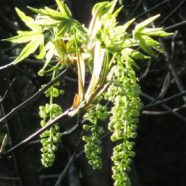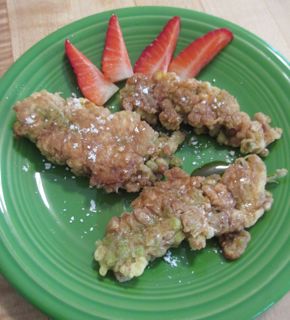
Each spring I look forward to seeing the blooms of big leaf maple trees illuminated in front of a dark stormy sky. Their golden-green color is also a dramatic contrast to the evergreens and the leaf-bare deciduous trees. They are so lush and so light-filled. The flowers are full of sweet nectar that pollinators and people relish. Try eating them straight, adding them to salads, or making maple blossom fritters.
Other Names: Acer macrophyllum, Oregon maple
Identifying Big Leaf Maple: As I think of big leaf maple several strong characteristics come to mind. The leaves are 5-lobed and are much larger than other maples – sometimes growing over a foot in diameter. Trees are very tall (up to 150 feet) with a multi-branching trunk and hefty branches that are often covered in mosses and licorice ferns – giving them a soft verdant look. Sometimes trees are so heavily covered that the bark is not visible anywhere on the trunk or main branches. The young bark is green and smooth, while the older bark becomes ridged and gray-brown colored.
Flowers bloom in March through April before the leaves emerge, and are greenish-yellow, and numerous on short stalks that hang in clusters. Each flower is bowl shaped with many pistols that have a downy fur at the base. They resemble tiny bird nests.
Fruits are shaped like 2 wings attached in a V pattern, and are 1-2 inches across. Big leaf maple is a prolific reproducer, both because the fruits travel like helicopters in the wind, and because the roots sprout vigorously when the tree is cut. Big leaf maple can grow 9 feet in a single year and it can live as long as 300 years. It is often home to a variety of plants, insects, birds, and tree dwelling creatures.
Where it Grows: Big leaf maple trees prefer wet forested areas from British Columbia to southern California, although they also grow in open fields in Olympia (a very soggy place). They grow from sea level to 5,500 feet.
Harvesting and Preparation
The flowers are harvested in spring when they are budding on the tip and fully open at the base of the flower cluster. They can be gathered from low branches or from the forest floor after a windstorm. When in full bloom, maple flowers should have a subtle but pleasant fragrance and sweet taste from their prolific nectar. They are easily stripped off the flower stem. They will last for a couple of days if picked and stored in the refrigerator in a glass or plastic container.
Eating the Spring Flowers
You can eat big leaf maple flowers straight in salads or as a garnish for soups. I prefer flowers that have just opened and are not super fuzzy inside yet. You can also add flowers to pancakes, quiche, and other baked goods. My favorite way to prepare them is as fritters. You can use the whole flowering cluster, or you can pick off individual flowers and mix them with batter to make pancake-like fritters.
Maple Flower Fritters
These are an easy and delicious spring delicacy. You can experiment by adding either dried or fresh herbs. Try both savory flavors like rosemary or garlic or sweet flavors like vanilla and cinnamon. If you are preparing sweet fritters, consider serving them drizzled with a little maple syrup!
1/2 cup flour
1/2 teaspoon baking powder
Pinch of salt and herbs or spices of choice
2 eggs beaten
¼ cup milk (cow, rice, almond, or even water if you do not have milk)
¼ cup oil for frying (sunflower, sesame, safflower, and coconut are favorites)
In a bowl, mix flour with salt and herbs or spices. In another bowl, whisk eggs with milk. Turn a medium sized sauté pan on medium-high heat and add oil. Once the oil is heated, dip maple flower clusters in the egg mixture first, then dust them with the flour mixture, and place them in the pan. Place 4-5 in the pan at a time. When the fritters are golden brown, flip them and let them brown on the other side. Let them drain on paper towels. Serve hot.
Variations – I have used Bisquick and other pancake and biscuit mixes for this recipe and it works fine. Blend a batter a little thinner than you would if making pancake batter, dip the flower clusters, and let the excess drip off before you put them in the pan. Gluten free pancake and biscuit mix can also be used for this recipe.
Big Leaf Maple Honey
My friend Benjamin Pixie of Pixie Honey first introduced me to our local maple flower honey. In March and early April, big leaf maple trees produce so many flowers that they turn the hillsides golden. They are one of the biggest nectar producing flowers in our region, and the honey that bees produce from it is light colored with a floral almost minty afternote.
Big Leaf Maple Syrup
I have several friends now who are tapping big leaf maple trees to make their own maple sugar and I have been lucky enough to partake in the sweetness of their labors. The syrup is similar to eastern sugar maple syrup but has a more delicate earthy flavor. My friend Jennifer Hahn recently served waffles with big leaf maple syrup and salal apple butter that still makes me smile. In her wonderful book Pacific Feast, she has a recipe for maple blossom crème brulee and maple blossom fritters.
Big leaf maple often grows near Western red cedar. Doctor Terry Maresca, Mohawk, has been tapping the trees for many years and she noticed that the sap becomes darker and more resinous if the trees are growing within 30 feet of a cedar. Recent research is showing that many plants and trees share chemical compounds and messages through their roots. Maple syrup spiked with cedar – sign me up! Dr. Maresca also shared that Eastern U.S. Tribes traditionally use maple sap for spring cleansing purposes and for use in making tea and soup.
Abe Lloyd from the Salal, The Cascadian Food Institute, just posted an excellent blog at http://arcadianabe.blogspot.com/2013/02/bigleaf-maple-syrup.html. He tapped many gallons and reduced it down to 1/30th the volume to get a good consistency of sugar in the syrup. If it is too thin it will mold, and if you reduce it too much it will turn to maple sugar, but oh the joy when it is just right!
Other Uses
Big leaf maple has been a highly valued tree throughout the ages. The Klallam People infused the bark for sore throats and turberculosis. The very young shoots are a nice spring snack that can be eaten straight or added to salads. They become astringent and slightly bitter as they get larger.
Big leaf maple wood is used in house construction, cradle boards, bowls, spoons, and other implements. It was called “paddle tree” by many tribes. The wood can be used for smoking meat or fish and as fuel.
Big Leaf Maple Meanderings
Around the time that I was 8 years old, I found an enormous big leaf maple on the edge of a graveyard in our neighborhood. Its giant moss-covered branches made it easy to climb and led to a nook that was a perfect spot to sit and ponder my changing world. I called it my Thinking Tree. I figured that it had easily outlived any of the people that were buried there starting in the 1850’s, and I hoped to absorb some of its quiet wisdom.
During summers I watched downy woodpeckers hop up and down the trunk digging for bugs. Crows comically grabbed the moss and flung it in all directions. I am still not sure if they were foraging or just having fun. Squirrels ran along the highway of branches. In autumn I laid on the dry grass to watch the way the leaves spin when they fall, especially in a breeze. It was delightfully disorienting and dreamy – a wonderful way to transition into autumn.
One spring, I stood under the massive canopy, a golden rain of pollen falling around me. The towering branches arched like a cathedral ceiling and I was suddenly in the presence of something much bigger. Here is what I learned – like a mother, maple gives. And it cultivates community. The shape of these trees makes me think in a circular pattern – branches reach up, arch out, and droop toward the earth. Blossoms drift down to the forest floor, later followed by leaves and winged seeds. These regenerate the soil and feed roots so that vitality and sap will rise again to create flowers and leaves. As I sit with big leaf maple, I learn the grace behind giving and receiving.
References:
Hahn, Jennifer. Pacific Feast. Seattle, Skipstone. 2010
Lloyd, Abe. Wild Harvests Blog. http://arcadianabe.blogspot.com/2013/02/bigleaf-maple-syrup.html
Maresca, Terry, Dr. Personal interview April 16, 2013.
Mooreman, Daniel E. Native American Ethnobotany. Portland, Or. Timber Press. 1998
Preston, Richard. North American Trees. Ames, Iowa: The Idaho State U. Press. 1980
Randall, Warren. Manual of Oregon Trees and Shrubs. Corvallis, OR. John Bell. 1998
Whitney, Stephen. Western Forests. New York, Alfred A Knoff, Inc. 1992.








No Comments
Trackbacks/Pingbacks